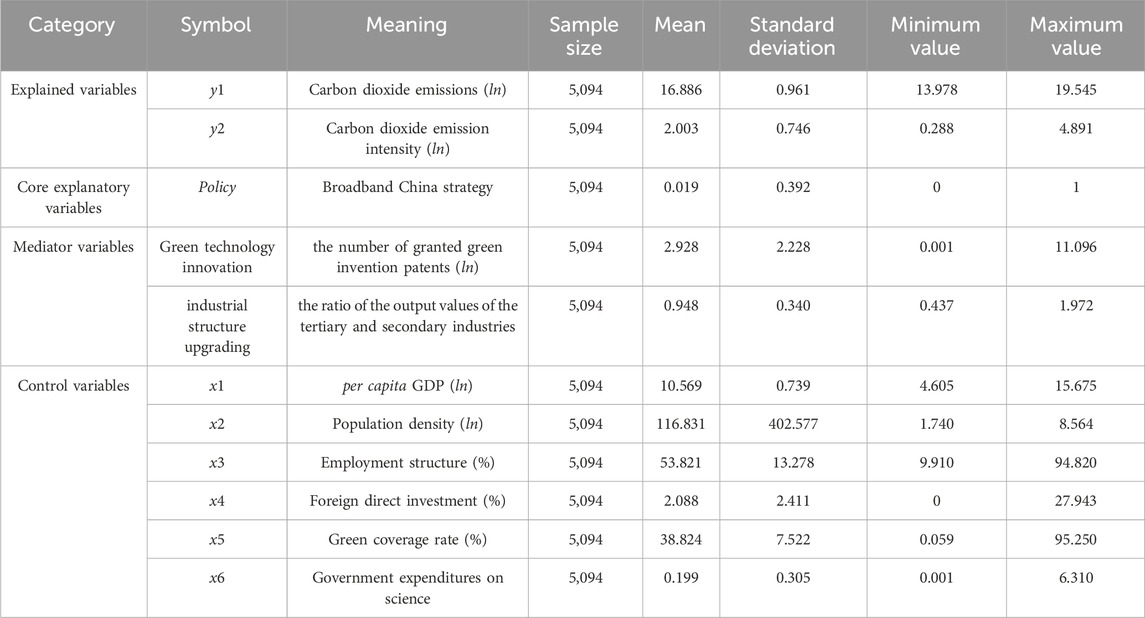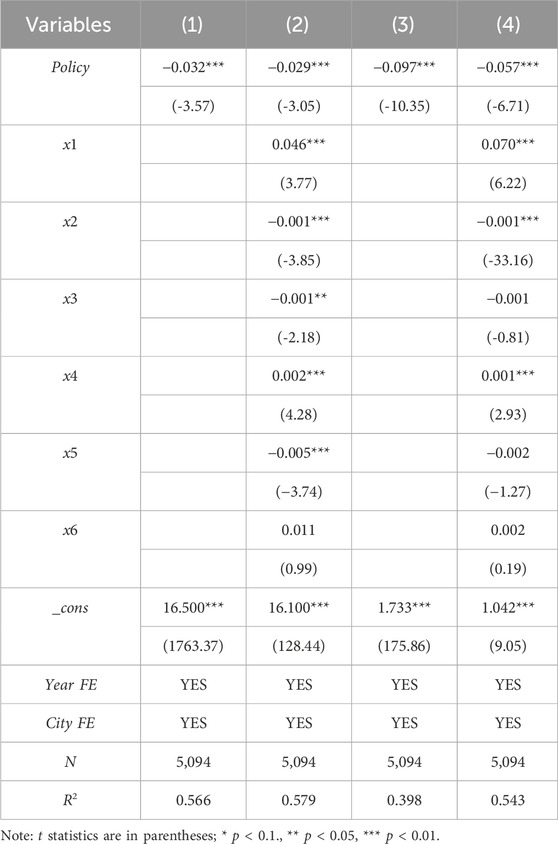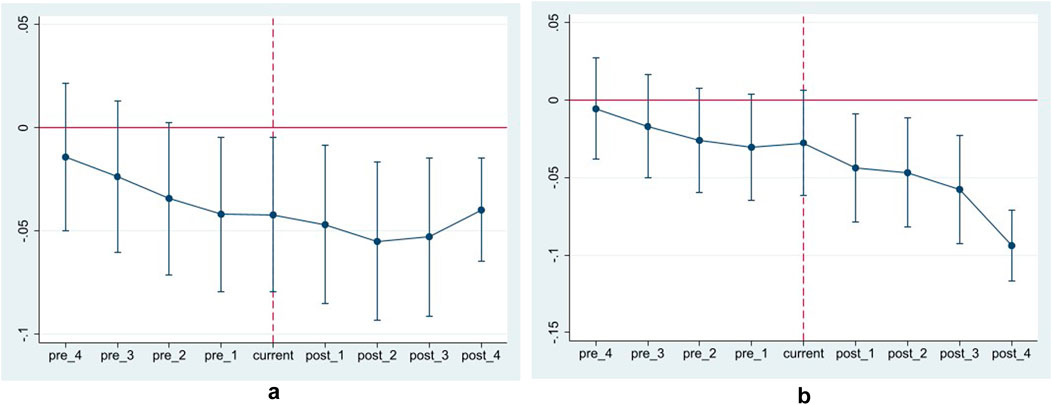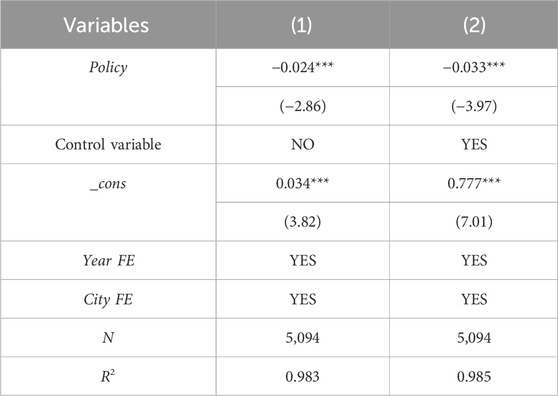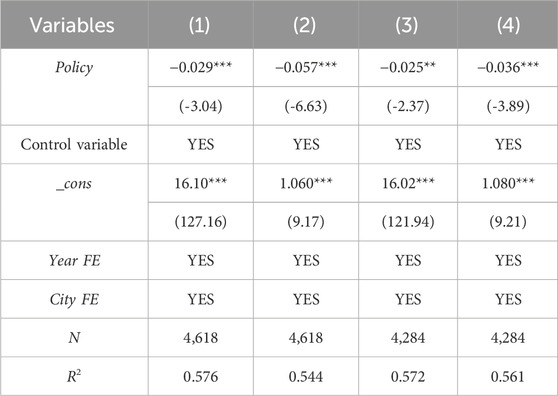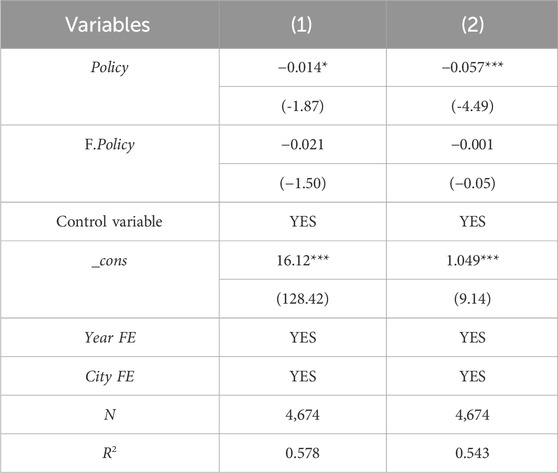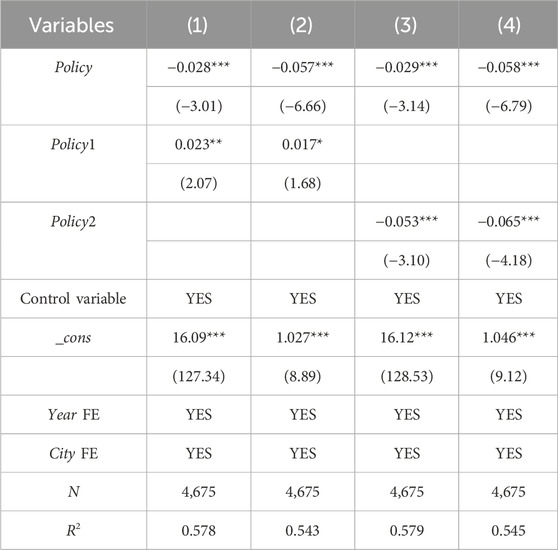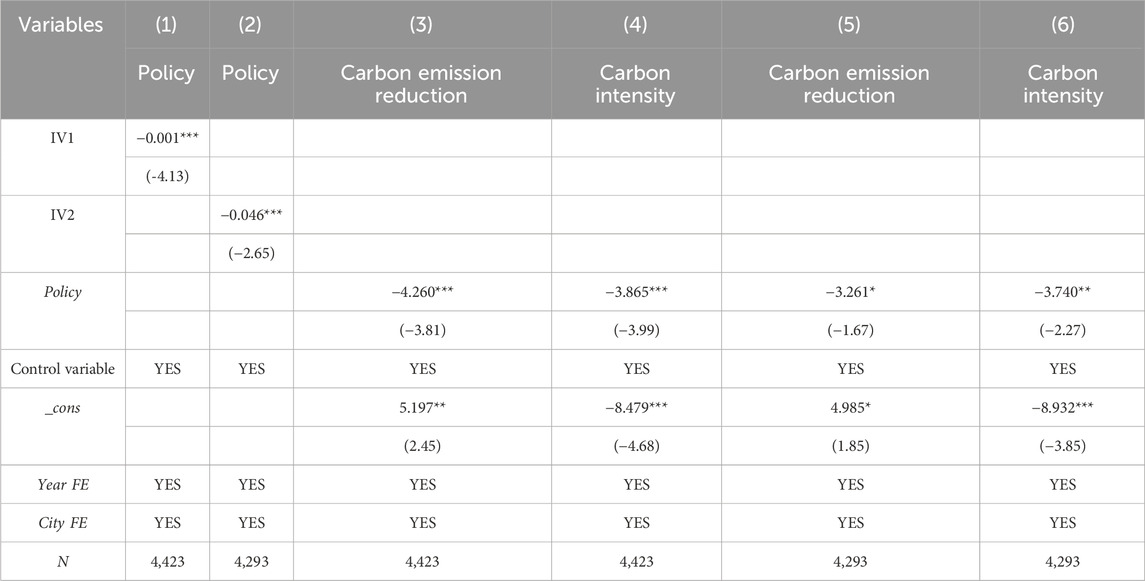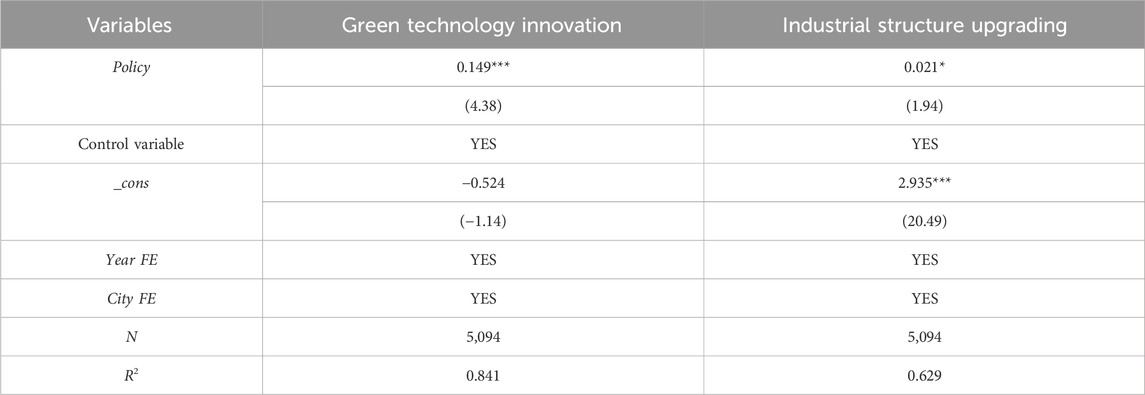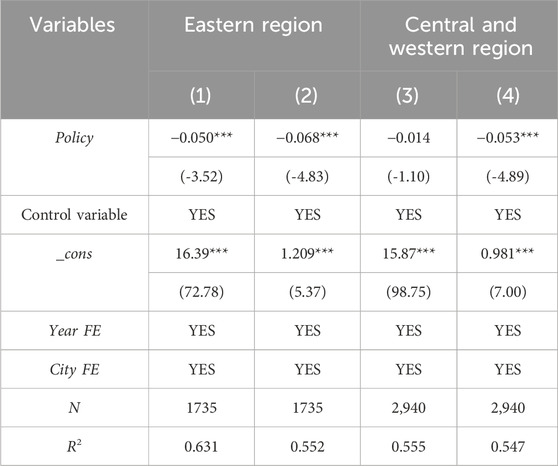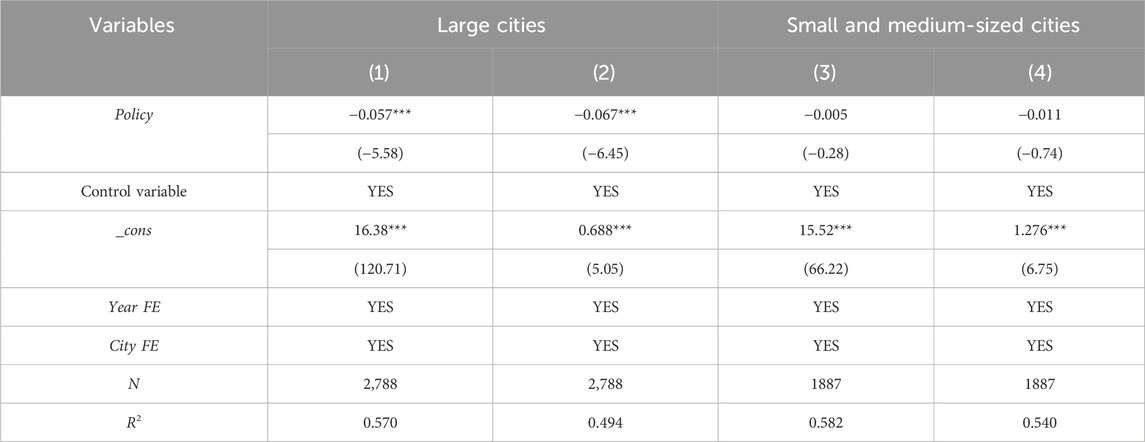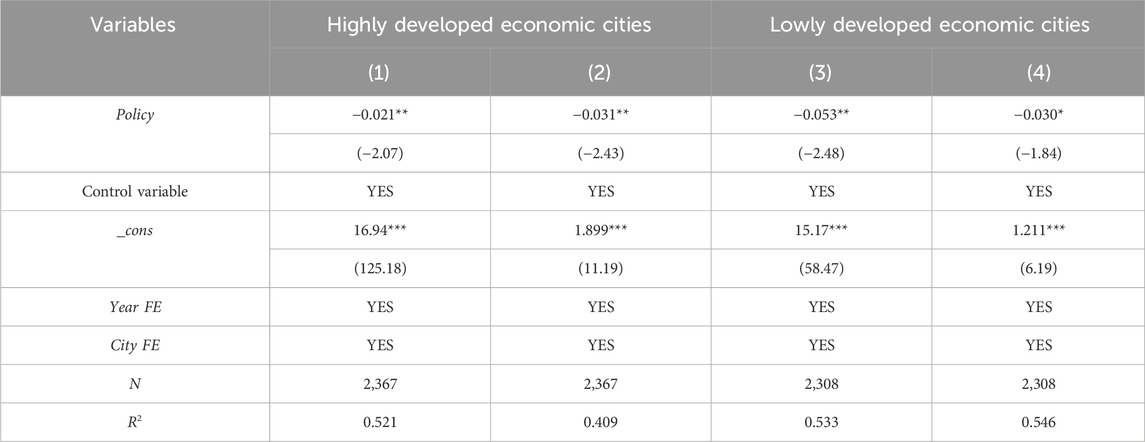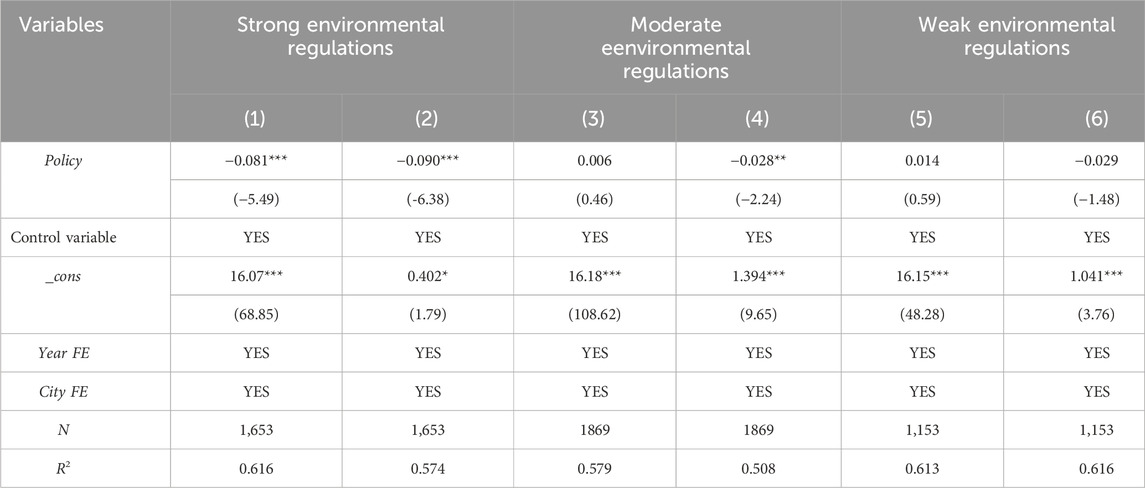- 1School of International Economics and Trade, Shanghai Lixin University of Accounting and Finance, Shanghai, China
- 2School of Finance and Business, Shanghai Normal University, Shanghai, Shanghai, China
- 3School of Economics, Shanghai University, Shanghai, Shanghai, China
Research on carbon emission reduction in China has focused on carbon market policies, technological innovation, and industrial institutional adjustment, but few studies have been concerned with the effects of the rapid development of China’s digital economy on carbon emission reduction. China’s vigorous development of digital infrastructure has led to the establishment of the Broadband China strategy as a quasi-natural experiment. A difference-in-differences model with data from 2006 to 2023 about 283 prefecture-level cities was applied to investigate the effects of China’s digital infrastructure construction on carbon emission reduction. The conclusions are as follows. First, digital infrastructure construction in these cities had significant reduction effects on carbon emissions and intensity. This conclusion was proven after a series of robustness tests such as parallel trends, the exclusion of central cities, and the replacement of explanatory variables. Second, a mediating effect test showed that green technology innovation investment and industrial structure upgrading are important mechanisms for digital infrastructure construction’s carbon emission reduction effects. Third, these effects have obvious heterogeneity and are stronger in the eastern region than in the central and western ones. Moreover, the effects are stronger with the expansion of urban scale, the improvement of urban economic development level, and the environmental regulation intensity. These conclusions have important relevance to China’s Digital Economy and “Dual Carbon” Policies.
1 Introduction
With the rapid development of new technologies such as mobile Internet, artificial intelligence, big data, and cloud computing, the role of digital infrastructure construction in economic development has become increasingly prominent. China’s digital economy has entered a critical phase characterized by scale expansion and value creation. Digital infrastructure systems anchored in 5G, AI, big data centers, industrial IoT, and smart energy grids are undergoing systematic enhancement. These systems exert transformative impacts across socioeconomic domains through their inherent permeability, network externalities, and scale effects, driving paradigm shifts in industrial production modalities, household consumption patterns, and governmental governance frameworks1. Against the backdrop of the “Dual Carbon” targets and accelerated digitalization, emerging technologies are enabling synergistic integration with carbon-intensive sectors including power generation, manufacturing, transportation, and construction. This technological convergence has catalyzed green innovation in energy systems, resource utilization efficiency, and environmental management, thereby injecting new momentum into low-carbon economic transitions2.
The strategic significance of digital infrastructure has been elevated to national policy priorities. Since the 2011 National Industry and Informatization Work Conference, China has institutionalized its digital transformation through the Broadband China strategy. Following its formal adoption as a national initiative in 2013, the Ministry of Industry and Information Technology (MIIT) and National Development and Reform Commission (NDRC) implemented a three-phase demonstration program, designating 120 pilot cities/city clusters between 2014 and 2016. These model cities spearheaded advancements in broadband penetration rates, network speed optimization, and urban-rural digital inclusion, generating substantial spatial spillover effects across regions2. Empirical evidence from the “China Digital Economy Development Research Report (2024)” indicates that China’s digital economy reached RMB 53.9 trillion in 2023, constituting 42.8% of GDP and contributing 66.45% to annual economic growth. This digital leap has not only redefined economic production frontiers but also triggered multidimensional societal restructuring.
The environmental externalities of digital infrastructure development are gaining scholarly traction. Groundbreaking studies reveal its dual role as both an economic accelerant and an ecological regulator. For instance, Ding et al. (2024) quantified the Broadband China strategy’s contribution to regional decarbonization, estimating a 12.7% reduction in per-unit GDP carbon intensity among pilot cities. Feng et al. (2023) identified smart grid deployments as critical in optimizing energy dispatch and curtailing fossil fuel dependence. Peng et al. (2024) further demonstrated that industrial IoT adoption in manufacturing sectors decreased sectoral emissions by 18.3% through predictive maintenance and process automation. These findings underscore digital infrastructure’s capacity to reconcile economic growth with environmental sustainability.
Nevertheless, critical knowledge gaps persist in understanding the mechanisms and heterogeneity of digital infrastructure’s carbon mitigation effects. Existing literature predominantly focuses on macroeconomic indicators, innovation spillovers, and industrial structure evolution, while paying insufficient attention to its environmental governance potential. To our knowledge, this study constitutes the first systematic examination of carbon emission reduction effects through the quasi-natural experiment framework of the Broadband China strategy. Utilizing panel data from 283 prefecture-level cities (2006–2023), we employ a staggered difference-in-differences (DID) approach to assess the policy’s dynamic impacts. Our multidimensional analysis incorporates regional heterogeneity tests across geographical zones, urban hierarchies, and economic development tiers, offering granular insights for targeted policymaking.
This research contributes to the field in four dimensions: Firstly, this paper takes carbon reduction as the starting point, enriching the research on the impact of digital infrastructure construction on urban economic development. Academic research on digital infrastructure construction mainly focuses on the macro-level impacts of regional productivity enhancement, economic development speed enhancement, industrial structure upgrading, and labor employment, while a few studies have focused on urban carbon emission reduction and other environmental quality issues related to the realization of China’s “dual-carbon” goal. Secondly, it has expanded the research on the driving forces behind urban carbon reduction. Unlike existing literature that explains the drivers of urban carbon reduction from the perspectives of environmental regulations and traditional urban infrastructure construction, this paper is based on the digital economy perspective, taking the impact of digital infrastructure construction on urban carbon reduction as the entry point. It not only supplements the traditional growth centered economic analysis, but also enriches the research on the influencing factors of carbon reduction effects. Thirdly, this paper deeply analyzes the role mechanism of digital infrastructure construction on urban carbon emission reduction effect and deepens the understanding of the role logic between digital infrastructure construction and urban carbon emission reduction. This paper constructs a mediating effect model to empirically test the role mechanism between digital infrastructure construction and urban carbon emission reduction in terms of digital development, which effectively enhances the validity and reliability of the empirical conclusions.
2 Literature review and research hypotheses
2.1 Policy background
Broadband network is an important part of modern digital information development. By providing fast and reliable Internet access services, it provides an important support for high-quality development of modern economy. To accelerate the widespread adoption of broadband infrastructure, the Chinese government issued the Broadband China Strategy and Implementation Plan in August 2013, which clearly promoted the popularization of high-speed, safe and green digital infrastructure in China through regional pilot. Subsequently, three groups of pilot cities were identified from 2014 to 2016, gradually expanding the pilot scope of Internet broadband access business opening. The Broadband China strategy focuses on the construction of digital infrastructure, and meets the needs of the majority of economic entities for high-quality Internet services by improving network coverage and transmission speed. By adopting a number of policy measures, such as increasing capital investment, strengthening government guidance and support, promoting cooperation among regions and sectors, and strengthening talent training and technological innovation, Broadband China is able to promote the convergence and development of broadband networks and other infrastructures. Thus, the Broadband China strategy is an important measure to promote the development of China’s digital economy, and can be used as a quasi-natural experiment to assess the construction of China’s digital infrastructure.
2.2 Literature review
The relationship between digital infrastructure and carbon reduction is essentially the relationship between the environmental effects of the digital economy. The digital economy is a new economic form formed by the information technology revolution and network infrastructure construction. Firstly, with the popularization of digital infrastructure centered on broadband network, it largely reduces the cost of spreading and searching for green and low-carbon information and increases the government’s ability to publicize the concept of urban green and low-carbon, which not only improves the city government’s ability to govern the environment, but also effectively reduces the city’s carbon emissions (Shahbaz et al., 2022). Secondly, with the construction of data infrastructure such as broadband China and cell phone base stations, digital media is increasingly entering residents’ lives. Through the promotion of digital media, residents’ attention to environmental issues is enhanced, guiding them to form green and low-carbon consumption concepts and lifestyles, promoting the implementation of green and low-carbon environmental protection concepts, and reducing urban carbon emissions (Strielkowski et al., 2022; Ma et al., 2023). Thirdly, digital infrastructure construction induces urban industrial agglomeration, which in turn promotes urban scale economy effect and technology diffusion effect, reduces information asymmetry between supply and demand sides of the market through the rapid dissemination of information, promotes the upgrading of industrial structure, and then promotes the occurrence of urban carbon emission reduction (Chen et al., 2025; Zhang et al., 2025).
Recent research has demonstrated that the environmental impacts of digital infrastructure development are becoming increasingly significant, with these effects being validated across multiple domains. Firstly, while rural areas historically experienced less digitalization influence compared to urban centers, recent digital infrastructure construction has driven substantial rural digital transformation. This shift has altered rural residents’ personal consumption patterns, including household energy consumption, which in turn promotes the use of clean energy in rural areas (Nguyen and Nasir, 2021). These findings have been confirmed by Yan et al. (2023). Secondly, in the industrial sector, where energy consumption such as electricity consumption and intensity is relatively high, digital infrastructure development has promoted technological optimization and industrial upgrading. These advancements have led to a marked reduction in industrial electricity demand, partially alleviating energy pressures while enhancing environmental efficiency (Williams, 2021; Wang et al., 2022). Thirdly, it promotes the green transformation of enterprises. Digital infrastructure helps enterprises optimize resource utilization efficiency through real-time data collection and analysis. On the other hand, it can integrate environmental monitoring data and provide accurate green management tools for enterprises, thereby promoting internal green upgrading (Zhong et al., 2022; Wu et al., 2023; Qian and Xi, 2024). In addition, the construction of digital infrastructure also has a significant impact on residents’ health (Xu et al., 2025).
The Broadband China strategy is an important element of digital infrastructure. A large number of empirical studies have been conducted on the relationship between the Strategy and environmental effects. Zou and Pan (2023) used broadband China as a quasi-natural experiment and empirically verified through DID and other methods that digital infrastructure construction can effectively reduce urban environmental pollution, and this pollution reduction effect is more pronounced in non resource-based cities, first and second tier cities, and eastern cities in China. Hong et al. (2023) build a time-varying difference-in-differences (time-varying DID) model based on the Broadband China pilot and find that digital infrastructure construction can significatively reduce prefecture-level energy intensity, and this environmental effect is more significant in Northeast China. For micro households, the broadband China strategy still has a significant impact. Zuo et al. (2024) through panel data on Chinese CFPS micro households, empirically tested based on the Broadband China strategy and found that digital infrastructure has the potential to indirectly increase household energy consumption through consumption upgrading and Internet development mechanisms, and that households in high-income, low-skilled, and rural areas, as well as those in areas with higher levels of development and marketization, are more deeply affected by digitalization, and household energy consumption will be more serious.
In summary, existing literature provide a good reference for this paper. Through the above literature, we have the following conclusions. Firstly, in terms of the choice of explanatory variables, a large number of studies have examined the economic impact or environmental impact brought about by the construction of digital infrastructure. Carbon emission reduction is an “extensive variable,” while carbon emission intensity, which is the amount of carbon emissions per unit of output value, is an “intensive variable.” Most studies tend to focus on one aspect, and there has not been sufficient attention given to measuring both as dependent variables simultaneously. Secondly, in the measurement of digital infrastructure construction, there are relatively few studies on the use of exogenous policy shocks. Research tends to favor selecting a single indicator or constructing a system of indicators, which may lead to certain biases in the results. Thirdly, most existing studies focus on the provincial or regional levels in China, or even at the enterprise level. Although some research involves the city level, the number of such studies is relatively limited. Fourthly, in heterogeneity studies, many researchers choose regional or city classifications, but these studies are relatively simplistic. There is a scarcity of research conducting heterogeneity analysis from the perspective of environmental regulation intensity. With the acceleration of urbanization in China, as an important economic carrier, cities have increasingly high requirements for environmental quality. Balancing the relationship between economic development and environmental quality is crucial for the sustainable development of cities. At the same time, the digital economy has become a new engine of economic development. It is worth exploring whether the construction of digital infrastructure, as an important component of the digital economy, can enable sustainable urban development.
Although the existing literature has provided valuable insights into the relationship between digital infrastructure and carbon emissions, there is still a need for further research to explore the specific mechanisms and heterogeneity of this relationship. This study aims to fill this gap by examining the carbon emission reduction effects of digital infrastructure construction in China, using the Broadband China strategy as a quasi-natural experiment.
2.3 Hypotheses
Specifically, the development of digital infrastructure can enhance the level of urban green technology innovation in the following ways.
Firstly, the digital infrastructure construction of the Broadband China strategy has broken down information barriers, promoted communication and cooperation among governments, enterprises, and research institutes, facilitated spatial agglomeration of human capital, and provided human support for green technology innovation (Song et al., 2024). Secondly, the construction of digital infrastructure has laid the foundation for the construction of digital technology, accelerated the speed of information dissemination of the Internet and big data, reduced network search costs and information transmission costs, promoted the increase of returns to scale through information sharing and knowledge spillover, and provided the possibility for the development of urban green technology innovation (Cassia et al., 2020; Du and Wang, 2024). Thirdly, the construction of digital infrastructure has promoted the spatial architecture and application scope of big data, cloud computing and the Internet, and has derived new businesses and industries with digital technology as the core. This drives high-energy-consuming industries to achieve green transformation, optimizes energy consumption structures, supports the research and development of clean, low-carbon, and green technologies, and promotes green technology innovation (Veile et al., 2022).
According to Zhang et al. (2023), green technology innovation plays a significant role in accelerating urban carbon emission reduction. Firstly, green technology innovation facilitates the transformation of high-pollution industries, reduces industrial energy consumption, and decreases carbon emissions from industries (Wang, 2022). Secondly, green technology innovation promotes the innovation of production equipment and technology in enterprises, reduces production costs, lowers resource utilization and consumption, improves product green quality, thereby enhancing environmental quality and reducing enterprise carbon emissions (Ning et al., 2022). Thirdly, green technology innovation drives the energy revolution and accelerates the development of clean energy, supporting the transformation and upgrading of the energy consumption structure (Guo et al., 2021), which is conducive to building a clean and low-carbon modern energy system. The improvement of green technology innovation levels can promote the green and low-carbon transformation of energy, increase the proportion of clean energy consumption, and advance the construction of new energy systems, thereby continuously reducing energy consumption and urban carbon emissions (Madaleno et al., 2022; Wang and Lai, 2024).
Hypothesis 1. Digital infrastructure development reduces carbon emissions by improving the level of green technology innovation.
Firstly, the development of digital infrastructure has promoted industrial digitization. Through the “crowding-out effect,” it facilitates the transformation and upgrading of industries characterized by high energy consumption, high emissions, and high pollution. By improving the overall energy utilization structure of these sectors, it further reduces carbon emissions (Du et al., 2022; Gao X. et al., 2023). Secondly, digital infrastructure has a “penetration effect.” Relying on the strategy of Broadband China, promote digital technologies such as the Internet, big data, cloud computing, etc., promote the digital transformation of enterprises, improve the whole industry chain supervision system of enterprises’ supply from the source, middle end production, and terminal utilization, which is conducive to improving energy utilization efficiency, reducing resource waste, and achieving the effect of carbon emission reduction (Wang et al., 2024). Thirdly, the construction of digital infrastructure enhances the supply efficiency of digital elements and the integration efficiency of various resources. This fosters the emergence of new business models and industries, promoting the optimization of urban industrial structures. The integration of the digital economy with traditional industries accelerates urban digital industrialization and industrial digitization, drives the digital transformation of traditional sectors, and ultimately achieves urban industrial upgrading (Su et al., 2021; Das, 2024).
Upgrading the industrial structure involves adopting more scientific production methods and optimizing the production processes, thereby reducing unnecessary energy consumption and effectively mitigating carbon emissions (Zhao et al., 2023). Firstly, with the upgrading of industrial structure, it will particularly trigger technological upgrading within the manufacturing industry, drive productivity improvement, trigger the “endogenous innovation” effect, and achieve the improvement of urban energy efficiency and carbon reduction effect in China (Xi and Zhai, 2023). Secondly, upgrading the industrial structure will lead to the elimination of a group of high polluting and high emission enterprises, while low-carbon and environmentally friendly enterprises will develop and grow. The transformation of clean and pollution-free production models has reduced the emissions of pollutants from enterprises and achieved sustainable environmental development (You and Zhang, 2022; Gao Y. et al., 2023). Thirdly, upgrading the industrial structure will improve the efficiency of resource allocation in various departments, enhance the interaction between departments and industries, reduce the proportion of agriculture and industry, promote the development of the tertiary industry, and effectively curb urban carbon emissions through “economic servitization” (Xue et al., 2022; Fu et al., 2024).
Hypothesis 2. Digital infrastructure construction reduces carbon emissions by upgrading industrial structure. The Conceptual framework see Figure 1.
3 Data and models
3.1 Model settings
The selection of Broadband China pilot cities is mostly affected by broadband access capability and penetration rate, which are not logically affected by the level of prefecture-level carbon emissions and carbon intensity. It provides a good opportunity to exclude the reverse causality problem. Difference-of-differences models are often used to assess the effect of policy implementation, and the traditional DID is only suitable for assessing the policy effect of a single time point shock. However, the approval of the Broadband China demonstration city is carried out in a step-by-step manner, which means that the timing of policy impact is not uniform (Hong et al., 2023). Based on this, to effectively identify the impact of digital infrastructure construction on urban carbon reduction, this paper regards the exogenous policy impact of the Broadband China demonstration city as a quasi-natural experiment and constructs the following time-varying DID model:
where Yit is the explained variable, indicating the regional carbon emissions and intensity of city i in year t; Policyit is the core explanatory variable, indicating whether the sample is selected as a Broadband China demonstration city. If the sample is selected, the value of this sample is 1 in this year and subsequent years. Otherwise, the value is 0. Its coefficient β1 represents the impact of digital infrastructure construction on urban carbon reduction, which is the focus of this study. Controli,t represents a group of control variables, which include per capita GDP, population density, employment structure, level of foreign direct investment, green environment, and level of scientific input by the government. τi indicates the city fixed effect. γt indicates the year fixed effect. Ɛit represents the random perturbation term.
3.2 Variable selection
3.2.1 Explained variables
The explained variable are urban carbon emissions and intensity. Amongthese, the carbon emissions (CO2) is expressed by the natural logarithm of the carbon emissions of each city, and the intensity of carbon emissions (CO2_intensity) is expressed by the ratio of carbon emissions of each city to the actual GDP (Pretis, 2022; Zhang et al., 2024). Because the urban carbon emission intensity has an obvious right skew, the log transformation for carbon intensity (lnCO2_intensity) is used in the regression (Zhang et al., 2023; Peng et al., 2024). The measurement method of the total carbon emission of each city draws on the research of Liang et al. (2024).
In Equation 2, CO2 represents the carbon emissions of each city; X includes electricity consumption, gas and natural gas consumption, urban transport consumption, and thermal energy consumption. βi represents the carbon dioxide conversion factor for Xi,mainly based on the research of Long et al. (2022). Equation 3 is the calculation method for carbon emission intensity.
3.2.2 Core explanatory variables
For a demonstration city, the value is 1; otherwise, it is 0. After excluding some autonomous prefectures (such as Yanbian), some urban districts (such as Jiangjin and Rongchang districts of Chongqing), county-level cities (Yongcheng in Henan), and some cities with serious data loss (Linzhi in Tibet), the final sample comprised 107 demonstration cities constituting the experimental group and the remaining 176 cities constituting the control group.
3.2.3 Mediator variables
The mediating mechanism includes green technology innovation and industrial structure upgrading. The former is represented by the number of granted green invention patents (Lv et al., 2021) and the latter is represented by the ratio of the output values of the tertiary and secondary industries (Jiang et al., 2020).
3.2.4 Control variables
To evaluate the carbon emission reduction effect of the development of digital infrastructure construction more accurately, other factors have been controlled. As shown in Table 1.
Economic development level (x1): China’s economic development is closely related to energy consumption. The “extensive” growth model often accompanies excessive energy consumption and waste, leading to a series of environmental problems. Drawing on existing research, this paper uses the GDP per capita to represent the level of economic development (Hao et al., 2021), Measuring the level of urban economic development by per capita GDP to control the impact of economic development on urban carbon emissions.
Population density (x2): Considering the significant differences in urban area and population size between cities, directly using the absolute number of population is not scientifically comparable. Therefore, this paper chooses to use population density, which refers to the number of people per unit area and the concentration of population life and production activities, which reduces the dispersed consumption of energy and resources and reduces urban carbon emissions (Zhang et al., 2023).
Employment structure (x3): The tertiary industry is dominated by knowledge intensive and service-oriented economic activities, such as finance, education, etc. Compared to industry and agriculture, its energy consumption and carbon emission intensity are significantly lower. Therefore, this paper selects the proportion of employees in the tertiary industry to represent the impact of employment structure on urban carbon emissions reduction (Hao et al., 2021).
Foreign direct investment (x4): The degree of openness reflected by foreign direct investment (FDI) is a fundamental factor that needs to be considered in China’s environmental pollution research. Existing research shows that the impact of FDI on carbon emissions is uncertain: the “pollution halo” hypothesis suggests that FDI can reduce carbon emissions by introducing environmentally friendly technologies and products (Shao et al., 2016); The “pollution haven” hypothesis suggests that FDI will worsen the environmental quality and exacerbate carbon emissions of host countries through the transfer of highly polluting industries (Musah et al., 2022). This paper uses the proportion of FDI to GDP to measure the degree of opening up to the outside world to examine its impact on China’s carbon emissions reduction.
Green coverage rate (x5): The higher the urban green coverage rate, the better the urban environment, which can effectively reduce carbon dioxide concentration and purify air quality. Therefore, this paper selects the ratio of green area to built-up area as the representation (Li &Wang, 2021).
Government science expenditure level (x6): Some studies suggest that when government science investment is focused on the production process rather than the green product end, it increases energy consumption and carbon emissions. This paper uses the proportion of science expenditure to fiscal expenditure to represent (Kuang et al., 2022).
The data from 2006 to 2023 for the 283 prefecture-level cities were mainly taken from the China City Statistical Yearbooks, China Statistical Yearbooks, China Industrial Enterprise Databases, National Environmental Monitoring Platform, National Oceanic Atmospheric Adminstration (NOAA), etc. Missing data have been supplemented by data from the Statistical Bulletin of National Economic and Social Development. The following cities were excluded from the total sample: data for Bijie and Tongren Cities were missing; Chaohu City was merged with Hefei City in 2011; Laiwu City was merged into Jinan City in 2019.
4 Empirical results and analysis
4.1 Baseline regression results
Table 2 shows the results of the baseline regression. Columns (1) and (2) give the estimated results of the effects of digital infrastructure construction on carbon emissions while (3) and (4) give those on carbon intensity. Columns (1, 3) and (2, 4) are respectively without and with the control variables. According to Table 2, when control variables are not considered, only time fixed effects and city fixed effects are controlled, and the Policy coefficient affecting carbon emissions and carbon intensity is significantly negative at the 1% level. When control variables are added, the Policy coefficient remains significantly negative at the 1% level, with coefficient values of −0.029 and −0.057, respectively. This indicates that the construction of digital infrastructure represented by the Broadband China strategy can significantly promote urban carbon reduction. Hong et al. (2023) reached similar conclusions. Among the control variables, The coefficient of x1 is significantly positive, indicating that the higher the level of urban economic development, the greater the urban carbon emissions. This conclusion is similar to the findings of Wang et al. (2024). The coefficient of x2 is significantly negative, indicating that the higher the urban population density, the more concentrated the urban layout and compact development, which reduces the dispersed consumption of energy and resources and reduces urban carbon emissions. The coefficient of x3 is significantly negative, indicating a higher proportion of employment in the service industry, lower dependence on energy, and greater reliance on human capital and information technology, thereby reducing the city’s carbon emissions and intensity. The coefficient of x4 is significantly positive, indicating that the more foreign direct investment a city introduces, the greater its carbon emissions, which to some extent verifies the “pollution shelter hypothesis.” The coefficient of x5 is significantly negative, indicating that the higher the level of urban greening, the more it helps to reduce the carbon content in the air, thereby achieving the effect of emission reduction. The coefficient of x6 is not significant, indicating that the level of urban science expenditure has little impact on urban carbon reduction.
4.2 PSM-DID method
To ensure the accuracy of the results of the DID method and overcome the systematic difference of changing trends between the cities in the experimental and control groups, we used the propensity score matching (PSM) method to test the robustness of the baseline regression. Also, to avoid sample size loss and alleviate selectivity bias as much as possible, we applied adjacent one-to-one matching. In Table 3, Columns (1) and (2) are the regression results of the PSM-DID method for carbon emissions and intensity. The regression results show that the Policy coefficients are significantly negative at the levels of 1%, which indicates that the Broadband China strategy for digital infrastructure construction has reduced carbon emissions and intensity, thereby proving that the benchmark regression results were robust.
4.3 Robustness tests
4.3.1 Parallel trend test
The premise of applying the time-varying DID model is that the parallel trend test should be satisfied. As for our research, satisfying the parallel trend test means that there is no significant difference in urban carbon emissions and intensity between the experimental group and the control group before being identified as a Broadband China demonstration city. To verify the parallel trend hypothesis, this paper adopt the research of Beck et al. (2010), use the “event analysis method” to check the common trend and dynamic effects of the Broadband China demonstration policy, further construct the following econometric model in Equation 4.
The regression results are shown in Figure 2. The abscissa, pre_4, pre_3, pre_2, and pre_1, represent 1–4 years, respectively, before current, which represents the year of the strategy’s implementation. post_1, post_2, post_3, and post_4 represent 1–4 years after implementation. The ordinate represents the regression coefficients of carbon emission reduction and intensity.
Before implementation, the strategy obviously has no effect, it did not have a significant impact on carbon emissions and carbon intensity. This indicates that there was no significant difference between pilot and non pilot cities before the implementation of the Broadband China strategy, meeting the parallel trend test. Meanwhile, After implementation, the regression coefficient is significantly negative, and the pilot cities have a significant carbon reduction effect, which also reflects the value and function of promoting digital infrastructure construction in environmental governance.
It should be noted that 1 year before the implementation of the Broadband China strategy, there was a significant negative correlation between policy and urban carbon emissions, indicating that there was a certain “expected policy effect” in the pilot cities. The economic logic behind it is that before the Broadband China strategy is officially launched in pilot cities, there will be certain discussions and preparations. Some pilot city governments may make preparations in advance to empower urban development with digital technology, indirectly affecting urban production and lifestyle, thereby reducing the total carbon emissions of pilot cities to a certain extent. There is a certain “policy lag effect” between policy and urban carbon intensity. Because carbon intensity is not only related to the total carbon emissions of the city, but also to the total GDP of the city’s economic development, the effect of the Broadband China strategy was not yet apparent in the year of its implementation. However, in the second year after the policy was implemented, the impact of the Broadband China strategy on urban carbon intensity became increasingly evident through digital technology empowering urban economic development.
4.3.2 Substitution dependent variable
We selected per capita carbon emissions as the explained variable for carbon emission reduction (Xuan et al., 2020). The regression results are shown in Table 4. Regardless of the addition of the control variables, the regression coefficient of Policy is significantly negative, which indicates the robustness of the baseline regression results.
4.3.3 Excluding key cities
Chinese cities include not only ordinary prefecture-level cities but also provincial capitals, municipalities directly under the central government, and economically developed cities. The behavior patterns of local city governments at different levels may be quite different and cities with higher administrative levels control far more resources than do ordinary cities (Yu and Zhang, 2021). To further verify the robustness of the conclusions regardless of the possible policy bias to key cities or big cities and the possible outliers in key cities that may bias the results, we excluded the key cities to test the carbon emission reduction effects of digital infrastructure construction. Table 5 gives the regression results for carbon emissions and intensity in Columns (1) and (2) after Beijing, Shanghai, Tianjin, and Chongqing have been excluded. Columns (3) and (4) show the results after the four municipalities directly under the central government and the provincial capitals have been excluded. Despite the exclusion of the municipalities directly under the central government or provincial capitals, digital infrastructure construction has still significantly reduced the carbon emissions and intensity, thus further verifying the robustness of the baseline regression.
4.3.4 Policy exogeneity
The multi-phase differential model requires that the experimental and control groups cannot form effective expectations before the implementation of the policy, i.e., the exogeneity of the policy must be guaranteed. We added into the regression equation the virtual term F. Policy of 1 year before the implementation of the Broadband China strategy (Qiu and Zhou, 2021). The regression results are shown in Table 6. After the addition of the control variables, as well as controlling for the city and time fixed effects, the regression coefficient of the core explanatory variable Policy is still significantly negative while the estimated coefficient of F. Policy in the previous year is not significant, thereby indicating no expected effect.
4.3.5 Eliminating the impact of potential policies
Regarding the baseline regression, we ask if the policy effect of the Broadband China strategy on urban carbon emission reduction is a net effect and if the reduction of carbon emissions and intensity has been affected by other relevant policies during the same period, leading to overestimation or underestimation of the results? In order to further test the robustness of the basic regression results, it is necessary to exclude other potential policies. Through sorting out other policies during the policy shock period, we found that the policy of the “National Big Data Comprehensive Pilot Zone” (Policy1) is closely related to the construction of digital infrastructure, while the policy of the “Carbon Market Construction Pilot Zone” (Policy2), as an environmental regulatory policy, is closely related to carbon reduction. Therefore, the policies of the “National Big Data Comprehensive Pilot Zone” (Policy1) and the “Carbon Market Construction Pilot Zone” (Policy2) may affect the estimation results of this study. In order to eliminate the interference of these strategies, this study considers the two types of strategies mentioned above in the baseline model of regression. When city i is determined as a pilot city for “National Big Data Comprehensive Pilot Zone” or “Carbon Market Construction Pilot Zone,” the duration of the national level big data comprehensive experimental zone (or carbon market construction pilot) of the city will be assigned a value of 1 in the jth year and beyond. Otherwise, assign a value of 0. In regression analysis, if the Policy regression coefficient is no longer significant after controlling for the above two policies, it indicates that the policy effect of the Broadband China strategy on the implementation of digital infrastructure construction does not exist, and the conclusion of this study is not robust; If other policies are added, the Policy regression coefficient remains significant but decreases, indicating that the impact of the Broadband China strategy on carbon reduction represented by digital infrastructure construction is overestimated, but it does not affect the conclusion of this study. According to the regression results in Table 7, Columns (1) and (2) are the regression results of joining the “National Big Data Comprehensive Pilot Zone,” and (3)-(4) are the regression results of joining the “Carbon Market Construction Pilot Zone.” The policy regression coefficient has not changed significantly compared to the baseline regression, and is still significantly negative at the 1% level. Therefore, the baseline regression results in this paper are robust.
4.3.6 Endogenous analysis
Despite controlling for several crucial variables that influence urban carbon reduction and using a year and city fixed-effects model to mitigate estimation bias, this study may not fully resolve the issue of endogeneity. Additionally, the inverse causality problem is considered insignificant since urban carbon emissions typically do not have a significant impact on digital technology facilities. To address potential endogeneity resulting from others, this paper employs the instrumental variable method to perform the endogeneity analysis.
This paper adopts the approach of Huang et al. (2019) and selects the number of post offices per million people and the number of landline telephones per hundred people in prefecture-level cities in 1984 as instrumental variables (IVs). The rationale for choosing these IVs is as follows: Firstly, the layout of post offices and the popularization of fixed telephones meet the exogeneity requirements of instrumental variables. The number of post offices and fixed telephones per million people in each prefecture level city in 1984 is difficult to directly affect urban carbon emissions reduction today; Secondly, the layout of post offices and fixed telephones can to some extent meet the correlation conditions of instrumental variables, and also reflect the information and communication needs of cities. The establishment of more post offices and high penetration rate of fixed telephones mean that their communication level is more developed compared to other regions, so they are likely to be the areas with leading digital infrastructure construction levels today. Therefore, this paper uses the interaction term between the number of post offices per million people in each city in 1984 and its Internet broadband access subscribers in the previous year (IV1), and the interaction term between the number of telephones per 100 people in each city in 1984 and its Internet broadband access subscribers in the previous year (IV2), respectively, as the instrumental variable for the choice of Broadband Chinastrategy.
The first-stage estimation result in Table 8 column (1-2) shows that the Policy are highly correlated with the instrumental variables, and the statistical test results of Kleibergen-Paap rk LM and Kleibergen-Paaprk Wald F pass the unidentifiable test and the weak instrumental variable test respectively, suggesting that IV1 and IV2 are valid. Column (3-6) gives the second-stage estimation result, the coefficients of Policy are all significant positive, the above estimation results show that the core conclusion of our study still holds after controlling the endogeneity problem.
5 Mechanism analysis
The above results show that the development of digital infrastructure construction has significantly reduced the carbon emissions and intensity of the pilot cities, so the empirical results are robust. We examined the mediating effect of carbon emission reduction achieved by digital infrastructure construction development from the perspective of green technology innovation and industrial structure upgrading mechanisms. Based on Equation 5, the model for the mediating effect is:
where M is the mediator variable, which represents green technology innovation and industrial structure upgrading. Green technology innovation is characterized by the number of granted green invention patents (Lv et al., 2021) and the industrial structure upgrading is the ratio of the output values of the tertiary and secondary industries (Jiang et al., 2020). The remaining settings are consistent with Equation 1.
5.1 Green technology innovation mechanism
In Table 9, Columns (1) is the estimated results of the green technology innovationmechanism. The coefficient of Policy in Column (1) is significantly positive at the level of 1%, indicating that digital infrastructure construction has a significant positive effect on urban green technology innovation, that is, digital infrastructure construction promotes the improvement of urban green technology innovation level. On the one hand, the construction of digital infrastructure means the gathering of high-tech talents such as digital technology, enhancing knowledge spillover, and improving the level of urban green technology innovation. The construction of digital infrastructure can improve urban energy efficiency, optimize resource allocation, and promote the improvement of urban green technology level (Wang et al., 2024). On the other hand, green technology innovation promotes the energy revolution and accelerates the development of clean energy, helping to transform and upgrade the energy consumption structure (Guo et al., 2022), which is conducive to building a clean and low-carbon modern energy system. The improvement of green technology innovation level can promote the green and low-carbon transformation of energy, increase the proportion of clean energy consumption, promote the construction of new energy systems, and continuously reduce energy consumption and urban carbon emissions. Therefore, green technology innovation is an effective means to solve environmental pollution problems (Acemoglu et al., 2012; Guo et al., 2022), and digital infrastructure construction can significantly reduce carbon emissions by improving the level of green technology innovation (Yuan et al., 2022).
5.2 Industrial structure upgrading mechanism
In Table 9, Columns (2) is the estimated results of the industrial structure upgrading mechanism. The coefficient of Policy in Column (2) is significantly positive at the level of 10%, indicating that the construction of digital infrastructure has a positive effect on the upgrading of urban industrial structure, that is, the construction of digital infrastructure promotes the improvement of urban industrial structure upgrading. On the one hand, digital infrastructure construction can promote the supply efficiency of enterprise digital elements, improve the integration efficiency of various element resources, and thus give birth to new formats and industries, promoting the optimization of urban industrial structure (Yi et al., 2022). The construction of digital infrastructure empowers urban digital transformation, promotes the integration of digital economy and traditional industries, accelerates urban digital industrialization and industrial digitalization construction, promotes the digital transformation and upgrading of traditional industries, and ultimately achieves the optimization and upgrading of urban industries (Su et al., 2021). On the other hand, upgrading the industrial structure can eliminate outdated equipment, transform the extensive economic development model of cities, and reduce the carbon emissions of high energy consuming and high polluting enterprises (Wu et al., 2021). Upgrading the industrial structure can promote the transformation of urban industries towards high technology and high added value, promote the development of low-carbon and clean industries, and significantly curb carbon emissions (Zhao et al., 2022). Therefore, the construction of digital infrastructure can reduce urban carbon emissions by promoting industrial structure upgrading.
6 Heterogeneity analysis
6.1 Heterogeneity analysis of different regions
To test for regional heterogeneity in the carbon emission reduction effects of digital infrastructure construction, we divided the 283 sample cities into an eastern regional group but the central and western regions together into another group, then introduced the interaction term of the cities and the Policy variable in each regional group into Equation 1. In Table 10, Columns (1) and (2) are the regression results of the effects of digital infrastructure construction development on carbon emissions and intensity for the eastern region while (3) and (4) are for the central and western ones. The carbon reduction effect of digital infrastructure construction is more evident in the eastern region, but the carbon reduction effect on the central and western regions is only reflected in carbon intensity, and the carbon emissions are not significant. The main reason may be that compared with the central and western regions, the eastern region has a high level of economic development, a good foundation for Internet development, flat terrain and convenient transportation, so the implementation of the Broadband China strategy has promoted the development of urban digital technology, and thus has a stronger effect on urban carbon emission reduction.
6.2 Heterogeneity analysis of different urban population sizes
We also classified the sample cities according to their population sizes by following the hierarchy criteria of the Outline of the National New Urbanization Plan issued by the State Council. Cities with more than 1 million urban residents are large cities; otherwise, they are small or medium-sized. An interaction term between the Policy variable and a dummy variable for city size was introduced into Equation 1 to test if city-size heterogeneity played a role in the carbon emission reduction effects of digital infrastructure development. In Table 11, Columns (1) and (2) show the regression results for the large cities, whereas (3) and (4) show those for the small and medium-sized ones. The regression results show that the carbon reduction effect of digital infrastructure construction in large cities is significant, while the carbon reduction effect in small and medium-sized cities is not significant. The possible reason is that large cities often have more advantages in Internet development foundation, financial strength and technology level, while the implementation of the Broadband China strategy plays a stronger role in promoting the upgrading of industrial structure and improving the ability of digital technology innovation, and the greater the impact on urban carbon emission reduction. However, the spatial agglomeration of carbon emission entities in small and medium-sized cities, especially enterprise entities, has not yet been fully included in the scope of emission control.
6.3 Heterogeneity analysis of differences in levels of economic development
To further analyze the differences in the carbon emission reduction effects of digital infrastructure construction in cities with different levels of economic development, Yao et al. (2017) applied the unchanged control variables and all other model settings by taking 50% as the median per capita GDP. The sample cities were divided into those above and below the median as respectively having high and low levels of economic development. In Table 12, Columns (1) and (2) represent the effects of digital infrastructure construction development in the high-level cities, whereas Columns (3) and (4) represent those in the low-level ones. The former group has seen more significant carbon emission reduction effects due to better digital infrastructure and stronger financial strength. The development of digital infrastructure construction can improve the rationalization and upgrading of urban industrial structure while having more significant inhibitive effects on urban pollution and emission reduction.
6.4 Heterogeneity analysis of different regions in environmental regulation intensity
Given the close relationship between urban carbon emissions and environmental regulations, and considering the varying intensity of environmental regulations across cities, the impact of digital infrastructure development on urban carbon emissions may exhibit heterogeneity. Accordingly, this study adopts the threshold model proposed by Yuan and Xie (2014) to estimate the annual average intensity of environmental regulations for the period 2006–2023. Based on these annual averages, cities are classified into three groups: strong, moderate, and weak regulation intensity. The results of the group-wise regression analysis, as presented in Table 13, reveal that digital infrastructure construction exerts a more pronounced carbon reduction effect in cities with higher environmental regulation intensity. This can be attributed to two primary mechanisms. First, stronger environmental regulation reflects a greater governmental commitment to addressing carbon emissions and environmental pollution, leading to more direct and stringent regulatory interventions. Second, stringent environmental regulations induce an “innovation compensation” effect, which incentivizes firms to enhance their green technology innovation capabilities, thereby generating a green Porter effect. This effect facilitates the production of cleaner products and contributes to carbon emission reduction. Consequently, the Broadband China pilot policy demonstrates a more significant carbon abatement effect in cities with stronger environmental regulation intensity.
7 Conclusion and policy recommendations
Using panel data from 2006 to 2023 of 283 prefecture-level Chinese cities in which the Broadband China strategy has been implemented, this study empirically examined the carbon emission reduction effects of the development of digital infrastructure construction by using the difference-in-differences method. The results are as follows. First, the development of digital infrastructure construction has had significant carbon emission reduction effects that simultaneously reduced carbon emissions and intensity. After a series of robustness tests, such as parallel trends, elimination of the central cities, and replacement of explained variables, this conclusion remained robust. Second, green technology innovation and industrial structure upgrading are two important mechanisms by which digital infrastructure construction has exhibited reduction effects. The construction of digital infrastructure can significantly reduce urban carbon emissions and carbon intensity by enhancing the level of green technology innovation and promoting industrial structure upgrading. Third, digital infrastructure construction development has had stronger effects in the eastern than in the central and western regions. Moreover, it has also shown stronger effects with the expansion of urban scales, the improvement of urban economic development level, and the environmental regulation intensity.
The above conclusions lead to the following policy suggestions. First, the development of digital infrastructure construction has obvious carbon emission reduction effects and plays an important role in improving urban environmental quality, so the government should further support the development and construction of new and more advanced digital network infrastructure. The diffusing effects of digital infrastructure construction should be enhanced, digital technology should be integrated into governance and the efficiency of governmental management should be improved to enhance the efficiency of the implementation of environmental protection policies.
Second, we should strengthen the integration of traditional and real industries, upgrade the industrial structure, and promote the green and low-carbon transformation of enterprises via digital technologies such as 5G, big data, cloud computing, and Internet Plus. Enterprises should increase investment in technological R&D, apply digital technology and network infrastructure to more industries and sectors, improve urban environmental quality through technological innovation, and achieve carbon emission reduction.
Finally, the heterogeneity of the carbon emission reduction effects of digital infrastructure construction has been fully analyzed. Compared with the eastern region, the central and western regions have lower levels of economic development and smaller populations. Although the level of the development of digital infrastructure construction is relatively backward, it has obvious advantages as a latecomer. For future development, digital technology, talent inputs, and innovation factors should be appropriately allocated to the central and western regions in order to enhance their abilities to improve environmental problems and realize environmental welfare.
Although this paper explores the carbon reduction effects of digital infrastructure construction based on 283 cities in China, several limitations still exist. For example, firstly, future scholars can use more micro county data or enterprise data for exploration. Secondly, scholars can seek more significant mechanisms to explore the impact and pathways of digital infrastructure construction on urban carbon reduction.
Data availability statement
The original contributions presented in the study are included in the article/Supplementary Material, further inquiries can be directed to the corresponding author.
Author contributions
HR: Conceptualization, Data curation, Formal Analysis, Methodology, Writing – original draft, Writing – review and editing. JZ: Data curation, Formal Analysis, Investigation, Methodology, Writing – original draft, Writing – review and editing. YY: Data curation, Methodology, Supervision, Writing – review and editing. MY: Conceptualization, Project administration, Validation, Writing – review and editing.
Funding
The author(s) declare that financial support was received for the research and/or publication of this article. This work was funded by Shanghai Qimingxing Project Sailing Plan (Grant No. 22YF1431000), Shanghai Shuguang Talent Plan Project (Grant No. 23SG53), Shanghai Oriental Talents Program.
Conflict of interest
The authors declare that the research was conducted in the absence of any commercial or financial relationships that could be construed as a potential conflict of interest.
Generative AI statement
The author(s) declare that no Gen AI was used in the creation of this manuscript.
Publisher’s note
All claims expressed in this article are solely those of the authors and do not necessarily represent those of their affiliated organizations, or those of the publisher, the editors and the reviewers. Any product that may be evaluated in this article, or claim that may be made by its manufacturer, is not guaranteed or endorsed by the publisher.
Supplementary material
The Supplementary Material for this article can be found online at: https://www.frontiersin.org/articles/10.3389/fenvs.2025.1510118/full#supplementary-material
Footnotes
1China Academy of Information and Communications Technology. China Digital Economy Development Research Report (2024). http://www.caict.ac.cn/kxyj/qwfb/bps/202408/P020240830315324580655.pdf.
2State Council. China Broadband Strategy Program. 2013. https://www.miit.gov.cn/ztzl/lszt/qltjkdzg2013zxxd/ywjj/art/2020/art_61518a71f7e548b49ffab24231c05168.html.
References
Acemoglu, D., Aghion, P., Bursztyn, L., and Hemous, D. (2012). The environment and directed technical change. Am. Econ. Rev. 102 (1), 131–166. doi:10.1257/aer.102.1.131
Beck, T., Levine, R., and Levkov, A. (2010). Big bad banks? The winners and losers from bank deregulation in the United States. J. Finance 65 (5), 1637–1667. doi:10.1111/j.1540-6261.2010.01589.x
Cassia, A. R., Costa, I., da Silva, V. H. C., and de Oliveira Neto, G. C. (2020). Systematic literature review for the development of a conceptual model on the relationship between knowledge sharing, information technology infrastructure and innovative capability. Technol. Analysis and Strategic Manag. 32 (7), 801–821. doi:10.1080/09537325.2020.1714026
Chen, Y., Jiang, C., Peng, L., Zhao, S., and Chen, C. (2025). Digital infrastructure construction and urban industrial chain resilience: evidence from the “Broadband China” strategy. Sustain. Cities Soc. 121, 106228. doi:10.1016/j.scs.2025.106228
Das, D. K. (2024). Exploring the symbiotic relationship between digital transformation, infrastructure, service delivery, and governance for smart sustainable cities. Smart cities 7 (2), 806–835. doi:10.3390/SMARTCITIES7020034
Ding, C.-J., Chen, H., Liu, Y., Hu, J., Hu, M., Chen, D., et al. (2024). Unleashing digital empowerment: pioneering low-carbon development through the broadband China strategy. Energy 295, 131034. doi:10.1016/J.ENERGY.2024.131034
Du, X., Zhang, H., and Han, Y. (2022). How does new infrastructure investment affect economic growth quality? Empirical evidence from China. Sustainability 14 (6), 3511. doi:10.3390/SU14063511
Du, Z.-Y., and Wang, Q. (2024). Digital infrastructure and innovation: digital divide or digital dividend? J. Innovation and Knowl. 9 (3), 100542. doi:10.1016/j.jik.2024.100542
Feng, Y., Li, L., and Chen, H. (2023). Carbon emission reduction effect of digital infrastructure: from the “Broadband China” Strategy. Ecol. Chem. Eng. S 30 (2), 283–289. doi:10.2478/ECES-2023-0030
Fu, C., Luo, C., and Liu, Y. (2024). The impact of structural upgrading of the service industry on regional ecologicalization efficiency of Industry: empirical evidence from 30 Chinese provinces. Heliyon 10 (1), e23817. doi:10.1016/J.HELIYON.2023.E23817
Gao, X., Li, C., Elahi, E., Abro, M. I., and Cui, Z. (2023a). Technological innovation, product quality and upgrading of manufacturing value chain: empirical evidence from China. Sustainability 15 (9), 7289. doi:10.3390/SU15097289
Gao, Y., Wang, Z., Wang, K., Zhang, R., and Lu, Y. (2023b). Effect of big data on enterprise financialization: evidence from China's SMEs. Technol. Soc. 75, 102351. doi:10.1016/j.techsoc.2023.102351
Guo, J., Zhou, Y., Ali, S., Shahzad, U., and Cui, L. (2021). Exploring the role of green innovation and investment in energy for environmental quality: an empirical appraisal from provincial data of China. J. Environ. Manag. 292, 112779. doi:10.1016/j.jenvman.2021.112779
Guo, Q., Wang, Y., and Dong, X. (2022). Effects of smart city construction on energy saving and CO2 emission reduction: evidence from China. Appl. Energy 313, 118879. doi:10.1016/j.apenergy.2022.118879
Hao, Y., Zhang, Z. Y., Yang, C., and Wu, H. (2021). Does structural labor change affect CO2 emissions? Theoretical and empirical evidence from China. Technol. Forecast. Soc. Change 171, 120936. doi:10.1016/J.TECHFORE.2021.120936
Hong, J., Shi, F., and Zheng, Y. (2023). Does network infrastructure construction reduce energy intensity? Based on the “Broadband China” strategy. Technol. Forecast. Soc. Change 190, 122437. doi:10.1016/J.TECHFORE.2023.122437
Huang, Q.-H., Yu, Y.-Z., and Zhang, S.-L. (2019). Internet development and productivity growth in manufacturing industry: internal mechanism and China experiences. China Ind. Econ. 8, 5–23. doi:10.19581/j.cnki.ciejournal.2019.08.001
Jiang, M., Luo, S., and Zhou, G. (2020). Financial development, OFDI spillovers and upgrading of industrial structure. Technol. Forecast. Soc. Change 155, 119974. doi:10.1016/j.techfore.2020.119974
Kuang, H., Akmal, Z., and Li, F. (2022). Measuring the effects of green technology innovations and renewable energy investment for reducing carbon emissions in China. Renew. Energy 197, 1–10. doi:10.1016/J.RENENE.2022.06.091
Li, P., and Wang, Z.-H. (2021). Environmental co-benefits of urban greening for mitigating heat and carbon emissions. J. Environ. Manag. 293, 112963. doi:10.1016/J.JENVMAN.2021.112963
Liang, J., Ding, R., Ma, X., Peng, L., Wang, K., and Xiao, W. (2024). The carbon emission reduction effect and spatio-temporal heterogeneity of the science and technology finance network: the combined perspective of complex network analysis and econometric models. Systems 12 (4), 110. doi:10.3390/SYSTEMS12040110
Long, H., Li, J., and Liu, H. (2022). Internal migration and associated carbon emission changes: evidence from cities in China. Energy Econ. 110, 106010. doi:10.1016/J.ENECO.2022.106010
Lv, C., Shao, C., and Lee, C.-C. (2021). Green technology innovation and financial development: do environmental regulation and innovation output matter? Energy Econ. 98, 105237. doi:10.1016/J.ENECO.2021.105237
Ma, Y., Shui, J., and Li, Y. (2023). Digital infrastructure and quality of life: a quasi-natural experimental study based on the ‘Broadband China’ pilot policy. Technol. Analysis and Strategic Manag., 1–14. doi:10.1080/09537325.2023.2298847
Madaleno, M., Dogan, E., and Taskin, D. (2022). A step forward on sustainability: the nexus of environmental responsibility, green technology, clean energy and green finance. Energy Econ. 109, 105945. doi:10.1016/j.eneco.2022.105945
Musah, M., Mensah, I. A., Alfred, M., Mahmood, H., Murshed, M., Omari-Sasu, A. Y., et al. (2022). Reinvestigating the pollution haven hypothesis: the nexus between foreign direct investments and environmental quality in G-20 countries. Environ. Sci. Pollut. Res. 29, 31330–31347. doi:10.1007/s11356-021-17508-0
Nguyen, C. P., and Nasir, M. A. (2021). An inquiry into the nexus between energy poverty and income inequality in the light of global evidence. Energy Econ. 99, 105289. doi:10.1016/j.eneco.2021.105289
Ning, J., Yin, Q., and Yan, A. (2022). How does the digital economy promote green technology innovation by manufacturing enterprises? Evidence from China. Front. Environ. Sci. 10, 967588. doi:10.3389/fenvs.2022.967588
Peng, H.-R., Ling, K., and Zhang, Y.-J. (2024). The carbon emission reduction effect of digital infrastructure development: evidence from the broadband China policy. J. Clean. Prod. 434, 140060. doi:10.1016/J.JCLEPRO.2023.140060
Pretis, F. (2022). Does a carbon tax reduce CO2 emissions? Evidence from British Columbia. Environ. Resour. Econ. 83 (1), 115–144. doi:10.1007/S10640-022-00679-W
Qian, Y., and Xi, X. (2024). Evaluating the policy effect of the “broadband China” strategy—from the perspective of urban entrepreneurship vitality. J. Knowl. Econ., 1–27. doi:10.1007/s13132-024-02294-0
Qiu, Z.-X., and Zhou, Y.-H. (2021). Digital infrastructure construction and regional total factor productivity: based on the analysis of the national big data comprehensive pilot zone. Financial Res. 47, 4–17. doi:10.16538/j.cnki.jfe.20210119.103
Shahbaz, M., Wang, J., Dong, K., and Zhao, J. (2022). The impact of digital economy on energy transition across the globe: the mediating role of government governance. Renew. Sustain. Energy Rev. 166, 112620. doi:10.1016/j.rser.2022.112620
Song, S., Wen, J., Li, Y., and Li, L. (2024). How does digital economy affect green technological innovation in China? New evidence from the “Broadband China” policy. Econ. Analysis Policy 81, 1093–1112. doi:10.1016/j.eap.2024.01.008
Strielkowski, W., Kovaleva, O., and Efimtseva, T. (2022). Impacts of digital technologies for the provision of energy market services on the safety of residents and consumers. Sustainability 14 (5), 2934. doi:10.3390/su14052934
Su, J., Su, K., and Wang, S. (2021). Does the digital economy promote industrial structural upgrading? a test of mediating effects based on heterogeneous technological innovation. Sustainability 13 (18), 10105. doi:10.3390/SU131810105
Veile, J. W., Schmidt, M. C., and Voigt, K. I. (2022). Toward a new era of cooperation: how industrial digital platforms transform business models in Industry 4.0. J. Bus. Res. 143, 387–405. doi:10.1016/j.jbusres.2021.11.062
Wang, C. (2022). Green technology innovation, energy consumption structure and sustainable improvement of enterprise performance. Sustainability 14 (16), 10168. doi:10.3390/su141610168
Wang, Q., Hu, A., and Tian, Z. (2022). Digital transformation and electricity consumption: evidence from the Broadband China pilot policy. Energy Econ. 115, 106346. doi:10.1016/j.eneco.2022.106346
Wang, S., Lai, Y., and Zhang, R. (2024). Can smart city construction reduce environmental pollution? Evidence from smart city pilot policy in China. doi:10.21203/rs.3.rs-4484699/v1
Wang, W., Wang, J., and Wu, H. (2024). Assessing the impact of new digital infrastructure on enterprise green transformation from a triple performance perspective. J. Knowl. Econ., 1–40. doi:10.1007/S13132-024-01976-Z
Williams, L. D. (2021). Concepts of digital economy and industry 4.0 in intelligent and information systems. Int. J. Intelligent Netw. 2, 122–129. doi:10.1016/j.ijin.2021.09.002
Wu, L., Sun, L., Qi, P., Ren, X., and Sun, X. (2021). Energy endowment, industrial structure upgrading, and CO2 emissions in China: revisiting resource curse in the context of carbon emissions. Resour. Policy 74, 102329. doi:10.1016/j.resourpol.2021.102329
Xi, B., and Zhai, P. (2023). Economic growth, industrial structure upgrading and environmental pollution: evidence from China. Kybernetes 52 (2), 518–553. doi:10.1108/K-02-2022-0279
Xu, Q., Li, X., Dong, Y., and Guo, F. (2025). How digital infrastructure development affects residents’ health: a quasi-natural experiment based on the “Broadband China” strategy. Cities 157, 105611. doi:10.1016/j.cities.2024.105611
Xuan, D., Ma, X., and Shang, Y. (2020). Can China’s policy of carbon emission trading promote carbon emission reduction? J. Clean. Prod. 270, 122383. doi:10.1016/j.jclepro.2020.122383
Xue, L., Li, H., Xu, C., Zhao, X., Zheng, Z., Li, Y., et al. (2022). Impacts of industrial structure adjustment, upgrade and coordination on energy efficiency: empirical research based on the extended STIRPAT model. Energy Strategy Rev. 43, 100911. doi:10.1016/J.ESR.2022.100911
Yan, J., Li, J., Li, X., and Liu, Y. (2023). Digital transition and the clean renewable energy adoption in rural family: evidence from Broadband China. Front. Ecol. Evol. 11, 1241410. doi:10.3389/fevo.2023.1241410
Yao, D., Ning, J., and Wei, S. (2017). How does the population aging affect technology innovation? J. World Econ. (China) (4), 105–128. doi:10.19985/j.cnki.cassjwe.2017.04.006
Yi, M., Liu, Y., Sheng, M.-S., and Wen, L. (2022). Effects of digital economy on carbon emission reduction: new evidence from China. Energy Policy 171, 113271. doi:10.1016/J.ENPOL.2022.113271
You, J., and Zhang, W. (2022). How heterogeneous technological progress promotes industrial structure upgrading and industrial carbon efficiency? Evidence from China's industries. Energy 247, 123386. doi:10.1016/j.energy.2022.123386
Yu, Y., and Zhang, N. (2021). Low-carbon city pilot and carbon emission efficiency: quasi-experimental evidence from China. Energy Econ. 96, 105125. doi:10.1016/j.eneco.2021.105125
Yuan, B., Li, C., Yin, H., and Zeng, M. (2022). Green innovation and China’s CO2 emissions–the moderating effect of institutional quality. J. Environ. Plan. Manag. 65 (5), 877–906. doi:10.1080/09640568.2021.1915260
Yuan, Y., and Xie, R. (2014). Research on the effect of environmental regulation to industrial restructuring——empirical test based on provincial panel data of China. China Ind. Econ. 14 (16), 10235. doi:10.19581/j.cnki.ciejournal.2014.08.005
Zhang, H., Di Maria, C., Ghezelayagh, B., and Shan, Y. (2024). Climate policy in emerging economies: evidence from China’s low-carbon city pilot. J. Environ. Econ. Manag. 124, 102943–102965. doi:10.1016/j.jeem.2024.102943
Zhang, H., Zhang, K., Yan, T., and Cao, X. (2025). The impact of digital infrastructure on regional green innovation efficiency through industrial agglomeration and diversification. Humanit. Soc. Sci. Commun. 12 (1), 220–315. doi:10.1057/s41599-025-04512-9
Zhang, W., Fan, H., and Zhao, Q. (2023). Seeing green: how does digital infrastructure affect carbon emission intensity? Energy Econ. 127, 107085. doi:10.1016/j.eneco.2023.107085
Zhao, B., Wang, K.-L., and Xu, R.-Y. (2023). Fiscal decentralization, industrial structure upgrading, and carbon emissions: evidence from China. Environ. Sci. Pollut. Res. 30 (13), 39210–39222. doi:10.1007/s11356-022-24971-w
Zhao, S., Peng, D., Wen, H., and Song, H. (2022). Does the digital economy promote upgrading the industrial structure of Chinese cities? Sustainability 14 (16), 10235. doi:10.3390/su141610235
Zhong, X., Liu, G., Chen, P., Ke, K., and Xie, R. (2022). The impact of Internet development on urban eco-efficiency—a quasi-natural experiment of “Broadband China” pilot policy. Int. J. Environ. Res. Public Health 19, 1363. doi:10.3390/ijerph19031363
Zou, W., and Pan, M. (2023). Does the construction of network infrastructure reduce environmental pollution? evidence from a quasi-natural experiment in “Broadband China”. Environ. Sci. Pollut. Res. 30 (1), 242–258. doi:10.1007/s11356-022-22159-w
Keywords: digital infrastructure construction, carbon emission reduction effect, “dual carbon” target, broadband China, difference-in-differences
Citation: Ren H, Zhou J, Yu Y and Ye M (2025) Carbon emission reduction effects of digital infrastructure construction development: the broadband China strategy as a quasi-natural experiment. Front. Environ. Sci. 13:1510118. doi: 10.3389/fenvs.2025.1510118
Received: 12 October 2024; Accepted: 31 March 2025;
Published: 22 April 2025.
Edited by:
Jiachao Peng, Wuhan Institute of Technology, ChinaReviewed by:
Pin Li, Xi’an University of Science and Technology, ChinaXi Xi, China Agricultural University, China
Copyright © 2025 Ren, Zhou, Yu and Ye. This is an open-access article distributed under the terms of the Creative Commons Attribution License (CC BY). The use, distribution or reproduction in other forums is permitted, provided the original author(s) and the copyright owner(s) are credited and that the original publication in this journal is cited, in accordance with accepted academic practice. No use, distribution or reproduction is permitted which does not comply with these terms.
*Correspondence: Jiawen Zhou, MjAyODAwODNAbGl4aW4uZWR1LmNuYujiang Yu, amlhbmd6aG9uZ3JpQDE2My5jb20=
†Correspondence should first be addressed to Jiawen Zhou (20280083@lixin.edu.cn)
 Huiming Ren1
Huiming Ren1 Jiawen Zhou
Jiawen Zhou
